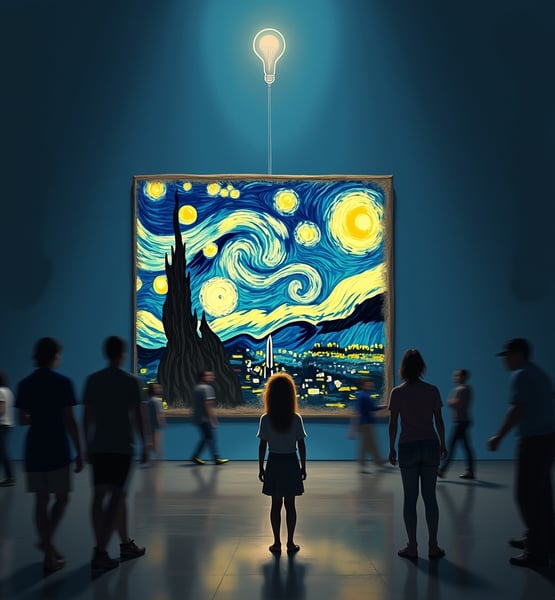When Art Speaks Your Heart: Using Music, Movies, and Books to Understand Yourself
There are moments in life when we can’t quite name what we’re feeling—but a single song lyric, a movie scene, or a line in a book can echo our emotional state so clearly it feels like it was written just for us. That’s not coincidence. Whether you’ve never stopped to think about the art resonating with you as coincidence or not, now is a good time to reflect back on certain times when it felt like the universe was taunting you, comforting you, inspiring you — and ask yourself why.
HEALTH
I'd Like That One Plz
6/12/20256 min read


When Art Speaks Your Heart: Using Music, Movies, and Books to Understand Yourself
There are moments in life when we can’t quite name what we’re feeling—but a single song lyric, a movie scene, or a line in a book can echo our emotional state so clearly it feels like it was written just for us. That’s not coincidence. Whether you’ve never stopped to think about the art resonating with you as coincidence or not, now is a good time to reflect back on certain times when it felt like the universe was taunting you, comforting you, inspiring you — and ask yourself why.
Acknowledging the golden linings of synchronicities that pop up when we least expect them—and then questioning why they moved us—is the key. Art holds a mirror to our inner world, often reflecting emotions we haven’t had the words for. Taking emotional growth seriously and making it a passion will do wonders for your mental health and overall well-being.
In a season of self-discovery, especially during the summer when emotions tend to bloom under long days and quiet nights, learning to use art as a tool for emotional understanding can be a game changer. Winter often feels like a time to retreat into our shells—to work on things inside the home and, symbolically, inside ourselves. The cold hardens the ground, and much of nature appears lifeless. But in summer, the warm air invites movement. It encourages outward activity, energizes emotional work, and burns off what’s been sitting dormant. It’s a time for shedding the winter blues. The sun shines brighter and more often, illuminating the areas of ourselves that are ready for growth.
A Personal Story
Dial the time machine back to circa 2010—those dreaded days of angst and brutal high-school years. Yuck. Sitting on the carpet floor so long the fibers added an unsightly—lovely—texture to my skin, curtains drawn, hiding away from the sun that I swore was mocking me with all its chipper happiness. I remember even thinking, "How cute. Even the sun wants to taunt me in my misery." (I was a real peach if you can’t tell.) Those bright days were some of the darkest.
But, you know what? I made it. Not only made it, but that version of me then is just that: then. This is now. That self-loathing, depressed, willingly stuck puddle of self-pity was left in that room, letting the carpet resurface my skin, growing paler from the sun I once cursed. She is in the past.
I remember that day clearly—what I wore, what I ate, where everyone else was. One silly, superficial comfort at the time was my little square mp3 player. (Yeah... we’re tattling on our ages here.) I listened to music on that thing so much, the nights and mornings ran together like melancholic watercolors.
Then, I don’t even know where the idea came from—but something prompted me to use a song that struck a nerve as a bridge to unpack the stuff. THE STUFF. Da da daaa. (Cue the dramatic soundtrack.) Whatever it was, I’m thankful beyond measure that I was prompted to use that song as a crutch to write down what I had buried. I sunk that pen into the paper with such tension that the ink stopped and I was etching my thoughts more than writing them. But here we are today—healthier, happier, and absolutely in love with the arts that life graciously gives us in abundance.
(A good-quality journal can make all the difference when you're ready to start writing down your own story—here’s one I love [Leather-lined, 300-page, unisex journal.)
1. Let Art Choose You
Instead of forcing a mood, try this: press play on a random playlist, pick a movie you’ve never seen, or open a book blindly to a page. Notice what stands out to you. What line hits you harder than expected? What emotion rises up? That response is a breadcrumb trail to something deeper inside you.
The randomness of picking a piece of art is important. Don’t let your ego or internal biases filter the experience before it begins. Letting art choose you means being open to unexpected insight—and being honest enough with yourself to recognize what surfaces. If being honest with yourself feels like a lot of work (no shame—many of us have to cross that bridge at some point), then pause and sit with that newfound self-confession. It’s easy—and dangerously common—to mold the truth into something more palatable, something that fits neatly into the current version of ourselves. But truth, even when it hurts, is a compass. What’s more damaging than temporary hurt is ignoring it entirely—because that blocks the healing and keeps us stuck.
Being open to randomness doesn’t mean avoiding intention—it means releasing control just enough to access something deeper. When we’re constantly steering toward comfort or familiarity, we shut out the very breakthroughs we need. Let yourself be surprised by what resonates. Sometimes the most healing revelations come from the things we didn’t seek out at all.
2. Ask Yourself Why It Resonates
When a certain lyric, scene, or quote moves you, pause and ask yourself: Why this? Why now? Maybe it reminds you of a past version of yourself. Maybe it expresses a hope, a wound, or a longing you’re carrying. Getting curious here is the first step to self-understanding.
Dig deeper. Ask if the emotion it stirs is familiar or foreign. Are you grieving something? Celebrating something? Longing for a different version of yourself or your life? This isn’t about psychoanalyzing every experience—it’s about gathering clues. The resonance you feel is an invitation to unpack the things you’ve tucked away.
3. Create a Feeling Playlist or Mood Shelf
Instead of organizing by genre, organize by emotional truth. Make a playlist called “When I Feel Invisible” or a shelf titled “Books That Get Me.” This turns art into a form of emotional reflection. You’ll begin to see emotional patterns—and maybe even release what needs to go.
This also helps future-you. When you’re feeling off, instead of asking “What do I want to listen to?” you’ll ask “How do I feel, and what understands that?” You’re not just building a media library—you’re building a mirror.
Want to make a Mood Shelf that reflects your emotional landscape? Check out this easy DIY guide to building your own Joy Shelf, which you can adapt to hold the books, music, or mementos that speak to your soul.
4. Be Mindful of Emotional Contagion
Just like art can help us process emotions, it can also deepen moods we’re trying to move through. If you’re feeling low, a melancholic song might feel comforting—but it can also keep you stuck. Be gentle and honest with yourself. Ask: Is this helping me move forward or just feel deeper?
There’s a difference between sitting with your sadness and swimming in it. Let yourself feel what’s real, but set the intention to move toward healing. Art can be a balm—but it can also be a loop. Know when to shift the station.
Art is just as impactful as talking to a friend about how you feel. Sometimes, like friends, a certain piece of art offers enlightening perspectives that help you move forward and grow. But other times, just like certain people, it can feed the fire instead of helping put it out. Learning which is which is part of the emotional skill-building process.
5. Use Art as a Conversation Starter—with Yourself
Try journaling about the characters, lyrics, or plotlines that stick with you. If you relate to a villain, a tragic character, or someone constantly overlooked, write about why. These reflections open doors to hidden parts of your emotional landscape.
It can be especially helpful because you are seeing someone or something else go through something similar to what you have or are currently experiencing. This vantage point — observing from the outside — can be enlightening, offering a fresh angle. Looking at your feelings through a different lens helps you see more clearly.
Ask yourself what parts of your personality or history this art reflects. Does the character make you feel seen or challenged? Does a lyric express what you haven’t yet had the courage to say out loud? Write it down. Name it. Respond to it. Art that resonates is asking for a reply.
If you want to start journaling but aren’t sure where to begin, picking up a beautiful, easy-to-write-in journal can inspire you to keep going [Unisex 190-page hardcover journal]
Final Thought
Art isn’t just decoration. It’s a language for the soul—a way to uncover what we feel, what we need, and what we’re ready to face. This summer, give yourself permission to get curious about your reactions. Let art be a guide—not just a soundtrack—to your emotional growth.
Optional Challenge:
Create a 3-part emotional art journal: one section for songs, one for books, one for movies. Track what resonates and why. You may be surprised what your preferences reveal about who you are—and who you’re becoming. Him
Never miss out on the happenings and promoted favorited products of "I'd Like That One Plz," by following our social platforms.
contact: IdLikeThatOnePlz@gmail.com
© 2025. All rights reserved.
-This site contains affiliate links. "As an Amazon Associate, I may receive commissions on qualifying purchases."-


